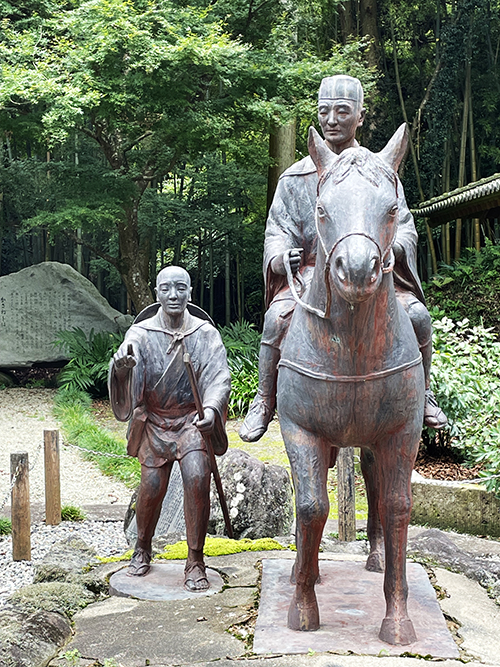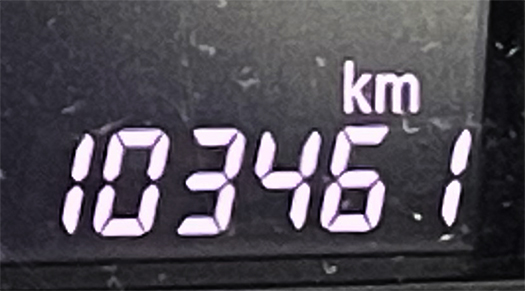
写真は「奥の細道」の芭蕉さんとその弟子・曾良さんの旅姿の銅造in栃木・黒羽。どういった考証だったのかはわかりませんが、博物館施設は公営のものなので、銅造依頼の根拠事実の発掘はそれなりだったのだろうと思います。たぶんこういった姿には信憑性が高いのだろうと。
江戸期の一定の「公職」従事者であった芭蕉さんは、乗馬しての旅行きが可能だったのだろうと思います。WEB検索で「奥の細道の移動総距離」と入力すると〜元禄2年(1689)3月27日、芭蕉は門人曾良を伴い江戸を発ち、奥羽・北陸の各地をめぐり、8月20日過ぎに大垣へ着くまでの、距離約六百里(約2,400キロ)日数約150日にも及ぶ長旅である。 旅の目的は、歌人能因や西行の足跡を訪ね、歌枕や名所旧跡を探り、古人の詩心に触れようとした。〜とある。
総移動距離と言うことでは、さらに芭蕉さんの時代から300年前後遡る南北朝騒乱期には、奥州勢力数万が京都まで移動したりしているので、馬と人足による移動手段自体は、そう大きくは変化していなかったように想像できる。


目的地は全然違うけれど、今回のわたしの総移動距離は4日間で1,537kmでした。芭蕉さんの総移動距離の5/8を、4/150日で走り回ったことになる。時代差は335年間。
広義の目的性では芭蕉さんとわたしの今回の旅は、畏れ多いですが同じ「表現のための取材行脚」という類似性。それに対して近現代の行脚はまことにありがたい科学進歩を享受できると実感。
ただしさすがに加齢してきたことは少し実感(笑)。昨日は夕方以降、旧知の方との情報交換をたっぷりさせていただきましたが、その直前にレンタカーは引き渡しして、あとは公共交通機関利用。だったのですが、さすがに多少の「疲労感」を感じております。
本日はようやく帰還するということで、多少ノンビリとベッドの上でストレッチしながら筋肉疲労箇所を特定して、筋肉伸ばしなどをしてみています。左足の大腿部などにコリを感じた。クルマ運転でいちばん多用する左足側にさすがに集中していた。クルマ運転で精神疲労以外にカラダからの筋肉疲労を実感するというのは珍しい。われながらよく持ってくれたなぁとカラダに感謝。
江戸期までの人間は時速4kmの歩きが中心。ただウォーキングっていうのは人類の基本動作なので、疲労への耐性が非常に強いようにも思える。しかしそれにしてもこういう長距離を移動しようと考えた発起心・昔人の行動意欲の強さには感嘆させられる。すごいですね、芭蕉さん。
English version⬇
[End of rental car travel, total distance traveled: 1,537 km/4 days].
In Basho’s time, horseback and foot were the basic means of transportation. Although some important persons used horseback transportation, we must take our hats off to those who were willing to use their physical strength and curiosity. The journey to the
The photo is a bronze sculpture of Basho and his disciple Sora from “The Narrow Road to the Deep North” in Kurobane, Tochigi. I do not know how the research was done, but since the museum facility is publicly operated, I think that the excavation of the facts on which the bronze sculpture was commissioned must have been done in a certain way. Perhaps there is a high degree of credibility in this kind of figure.
Basho, who was a constant “official” during the Edo period (1603-1868), could have traveled on horseback, and a web search for “total distance traveled on the Narrow Road to the Deep North” shows that – on March 27, 1689 (Genroku 2), Basho left Edo accompanied by his student Sora, traveled around Ou and Hokuriku regions, and arrived in Ogaki after August 20, 1689 (Genroku 2). It was a long journey of about 150 days, covering a distance of about 600 ri (about 2,400 km). The purpose of the journey was to visit the footsteps of the poets Noin and Saigyo, to explore the poetry pillars and historic sites, and to experience the poetic spirit of the ancients. 〜The total distance traveled is 1,000 kilometers.
In terms of the total distance traveled, it would seem that the means of transportation itself, by horse and foot, did not change much since several tens of thousands of Oshu forces traveled as far as Kyoto during the period of the Nanboku-cho uprisings, some 300 years earlier than Basho’s time.
Although our destinations were completely different, my total distance traveled this time was 1,537 km in 4 days. This means that I traveled 5/8 of Basho’s total distance in 4/150 days. The time difference is 335 years.
In the broad sense of purpose, Basho’s and my trip are awe-inspiring, but they are similar in that they are both “expeditions to gather information for the purpose of expression. In contrast, I realize that the modern and contemporary travelers are able to enjoy scientific progress for which I am very grateful.
However, I am indeed feeling a little older (laugh). Yesterday evening, I had a lot of time to exchange information with old acquaintances, but I handed over my rental car just before the meeting and used public transportation. I had to leave the rental car just before that, and the rest was done by public transportation, but as expected, I am feeling a little “tired.
Today, as I am finally returning home, I am relaxing on my bed, stretching my muscles, trying to identify the areas of muscle fatigue, and doing muscle stretches. I felt stiffness in my left thigh and other areas. It was concentrated on the side of the left leg that is used most frequently when driving a car. It is rare to feel muscle fatigue from the body other than mental fatigue when driving a car. I was grateful to my body for holding up so well.
Until the Edo period, people mainly walked at a speed of 4 km per hour. Walking is the basic movement of human beings, so it seems that they have a very high tolerance for fatigue. But even so, I am amazed at the strength of the initiator’s mind and the old people’s willingness to take action who thought of traveling such a long distance. It’s amazing, isn’t it, Mr. Basho?
Posted on 9月 17th, 2024 by 三木 奎吾
Filed under: 日本社会・文化研究







コメントを投稿
「※誹謗中傷や、悪意のある書き込み、営利目的などのコメントを防ぐために、投稿された全てのコメントは一時的に保留されますのでご了承ください。」
You must be logged in to post a comment.